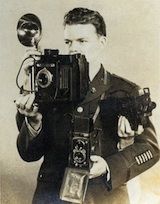- Forum
- General Discussion | Introductions | Off Topic Forum
- Photography General Discussion
- Wedding,Whitebalance,metering
Wedding,Whitebalance,metering
-
 Topic Author
Topic Author
- tennis man
- New Kid On The Block
-
- Canon t2i
- Followers: 6
- Posts: 47
-
Points:
0
Post #148253
-

- lawson fhoto
- New Kid On The Block
-
- Canon t2i
- Followers: 4
- Posts: 41
-
Points:
0
Post #148256
-
 Topic Author
Topic Author
- tennis man
- New Kid On The Block
-
- Canon t2i
- Followers: 6
- Posts: 47
-
Points:
0
Post #148259
lawson fhoto wrote: Shoot aperture mode in RAW, and correct to the dress/tux in post processing.
I don't like shooting raw. It's a pain.
-

- lawson fhoto
- New Kid On The Block
-
- Canon t2i
- Followers: 4
- Posts: 41
-
Points:
0
-
 Topic Author
Topic Author
- tennis man
- New Kid On The Block
-
- Canon t2i
- Followers: 6
- Posts: 47
-
Points:
0
Post #148263
lawson fhoto wrote: Shooting a wedding in .jpg only?
Ahh . . . not another JPEG/RAW debate. Isn't the post processing incredibly tedious for shooting in RAW?
-

- lawson fhoto
- New Kid On The Block
-
- Canon t2i
- Followers: 4
- Posts: 41
-
Points:
0
Post #148266
-

- rmeyer7
- Master of the Lens
-
- Canon 6D, Canon 5D mk. ii, Canon 50D
- Followers: 105
- Posts: 1640
-
Points:
2086
Post #148267
-

- lawson fhoto
- New Kid On The Block
-
- Canon t2i
- Followers: 4
- Posts: 41
-
Points:
0
Post #148275
rmeyer7 wrote: Though it might be tedious, I think weddings are the one time every photographer should use RAW. The rates you charge for a wedding should be taking into account the post processing time. And a wedding is one of the most important days of a client's life, so the attention and diligence we use in photographing and post processing their photos from that day, IMHO, should be something we take very seriously as photographers. There are no do-overs for these precious photos, we have to get them right
-
 Topic Author
Topic Author
- tennis man
- New Kid On The Block
-
- Canon t2i
- Followers: 6
- Posts: 47
-
Points:
0
Post #148277
-

- MLKstudios
- Banned
-
- D800 ;-)
- Followers: 72
- Posts: 4480
-
Points:
2
Post #148280
It allows you to edit hundreds (or thousands) of images quickly.
HTH
eta These tutorials will get you running:
tv.adobe.com/product/lightroom/
Matthew L Kees
MLK Studios Photography School
www.MLKstudios.com
[email protected]
"Every artist, was once an amateur"
-

- lawson fhoto
- New Kid On The Block
-
- Canon t2i
- Followers: 4
- Posts: 41
-
Points:
0
Post #148281
tennis man wrote: Last time I shot in RAW, it looked so grainy. Probably user defect again?
If it was grainy, you either had really high ISO or not using any noise reduction.
-
 Topic Author
Topic Author
- tennis man
- New Kid On The Block
-
- Canon t2i
- Followers: 6
- Posts: 47
-
Points:
0
Post #148282
MLKstudios wrote: Sounds like you need to simplify your post work a bit. Try Adobe Lightroom when using RAW.
It allows you to edit hundreds (or thousands) of images quickly.
HTH
eta These tutorials will get you running:
tv.adobe.com/product/lightroom/
Thanks, but I don't like shooting raw, I find it to be a pain...no matter what software I PP with.
-

- MLKstudios
- Banned
-
- D800 ;-)
- Followers: 72
- Posts: 4480
-
Points:
2
Post #148285
Matthew L Kees
MLK Studios Photography School
www.MLKstudios.com
[email protected]
"Every artist, was once an amateur"
-

- photobod
- Paparazzi
-
- Nikon D800 + D300
- Followers: 563
- Posts: 8907
-
Points:
150
Post #148346
As for processing raw being a pain it is actualy no different to processing a jpeg, you bring the pictures into your software and work on them, the difference is that in raw you can alter so much more if you want to, it gives you more options, to a photographer it is a bonus, it sounds to me like you are very inexperienced and scared of raw.
In photography we strive for the best for our clients or friends and family, that is because we care, Its not an argument about whats best jpeg or raw, there is no argument it is a plain fact that raw is best, it is the photographers best friend, his negative, what could be simpler than that.
www.dcimages.org.uk
"A good photograph is one that communicate a fact, touches the heart, leaves the viewer a changed person for having seen it. It is, in a word, effective." - Irving Penn
-

- Henry Peach
- Apprentice
-
- I currently use a 5DII or Sony Nex-3 most of the time.
- Followers: 50
- Posts: 2925
-
Points:
16
Post #149113
Setting a custom wb every time the lighting color changes: indoor, outdoor, different/mixed artificial lighting, flash or no flash, light reflecting off different colored walls, etc....
or
Adjust wb by eye on a calibrated monitor.
Personally I find constantly checking for custom wb on a busy wedding day much more tedious.
Out-of-camera processing can be automated just like in-camera processing. You could shoot raw, and batch process all your photos with the raw software that came with the camera. It should be able to duplicate the in-camera, jpeg processing (Canon's DPP will for sure). Then you could just adjust wb as needed.
Setting the camera to raw is going to turn off most (maybe not all) of the in-camera noise reduction, but I find the noise reduction tools available out-of-camera to be much nicer than the ones installed in cameras. When I'm pushing the limits of high ISO I definitely want a raw file to work with, not a jpeg that's already got in-camera NR and sharpening artifacts embedded.
If you absolutely don't want to shoot raw, then you have to live with the limitations of the in-camera processing. That means regularly adjusting wb, or living with what you get. We used to just accept it. Back the days of film I only carried daylight balanced film. I had some warming and cooling filters, but when shooting weddings I just lived with whatever color the light (and lab processing) gave me. In comparison raw processing seems like a wonderful dream.
- Forum
- General Discussion | Introductions | Off Topic Forum
- Photography General Discussion
- Wedding,Whitebalance,metering
Latest Reviews
The Olympus Pen E-P7 is an affordable micro four thirds mirrorless camera with 4K video capabilities, a 20.3MP sensor, and 121 focus points, making it a solid entry-level camera for beginners.
The Panasonic G9 II is a 25.2-megapixel micro four thirds camera with numerous features that make it punch out of its weight class, like 779 AF points, 5.8K video, and weather sealing.
The Fujifilm XT5 is a 40MP mirrorless camera capable of 6.2K video at 30p. With those specs, it’s an ideal choice for photographers needing a camera to pull double duty for imaging and video.
The Canon EOS R100 is an entry-level mirrorless camera introduced in 2023. But just because it’s an entry-level camera doesn’t mean it’s a bare-bones camera. Find out why in this review!
Forum Top Posters
-
1Scotty 7 posts
-
2Roman Omell 4 posts
-
3Razky 4 posts
-
4Ruby Grace 3 posts
-
5Pat White 3 posts
-
6Nefarious 3 posts
-
7ShutterPal 3 posts
-
8Roger Lang 3 posts
-
9Jim Photo 3 posts
-
10CharleyL 3 posts
Latest Articles
Upgrade your kit in 2024 with the best intermediate camera on the market! The question is, what camera fits the bill? We’ve got three top options for you to choose from in this buyer’s guide.
The best photography jobs right now are a mix of tried-and-true gigs like wedding photography and new jobs highlighting AI’s capabilities, travel, and videography.
The Olympus Pen E-P7 is an affordable micro four thirds mirrorless camera with 4K video capabilities, a 20.3MP sensor, and 121 focus points, making it a solid entry-level camera for beginners.
Starting a photography business is one thing; sustaining your business over a long period of time is another. Use the tips in this professional photography guide to build something with longevity!
The Panasonic G9 II is a 25.2-megapixel micro four thirds camera with numerous features that make it punch out of its weight class, like 779 AF points, 5.8K video, and weather sealing.
Cinematic photography is an interesting genre that combines photographic and videographic skills along with effective storytelling techniques. The result? Highly impactful images!
Newborn photography requires skill, the right gear, and a lot of patience. This beginner’s guide discusses critical topics that will help you be more prepared for before, during, and after the shoot.
To fill the frame means to expand the footprint of the subject in your shot. Get in close, zoom in, crop the image, or use other techniques to bring the subject to the forefront.
















